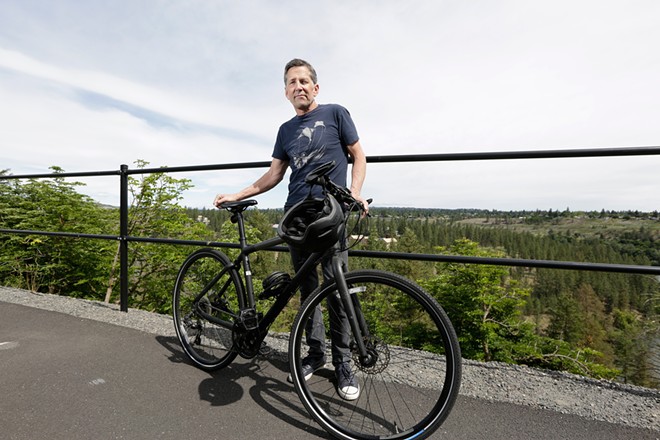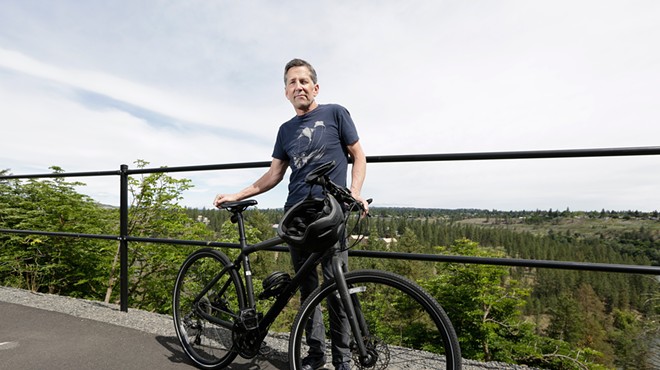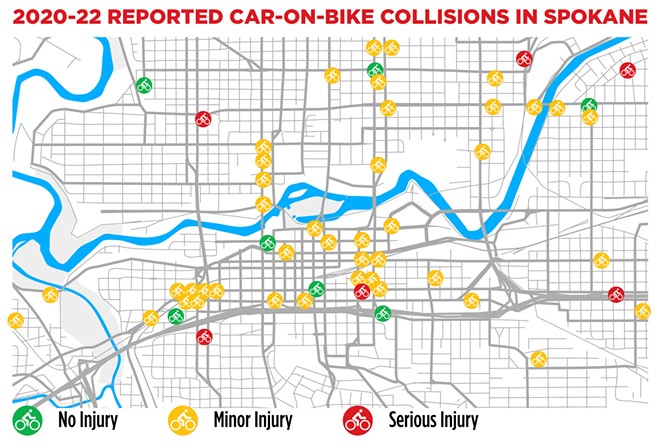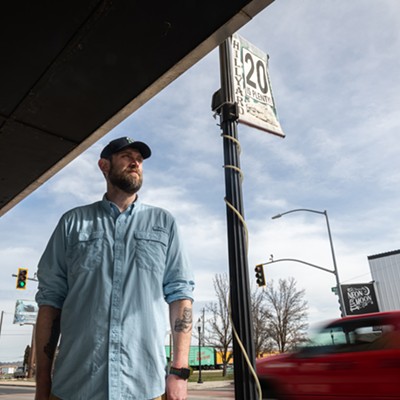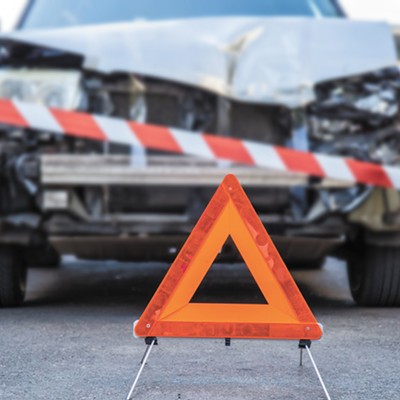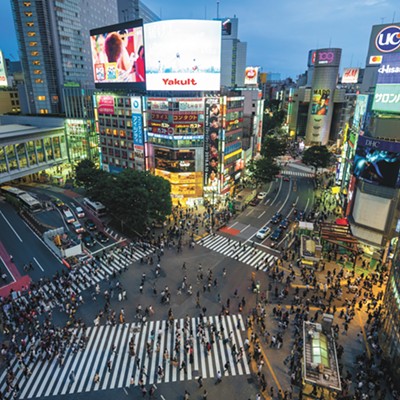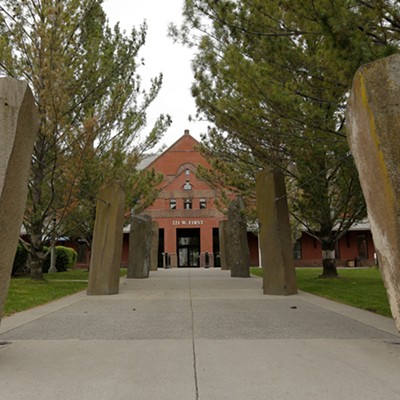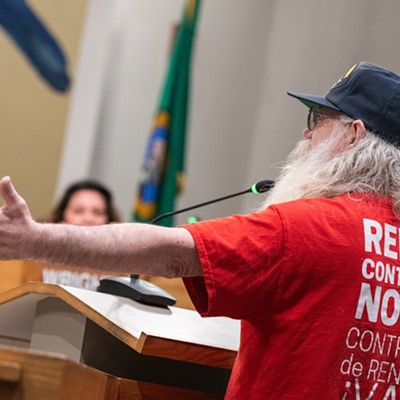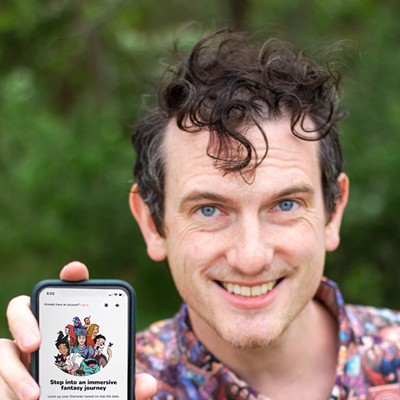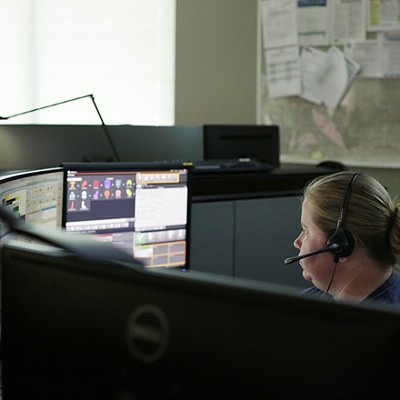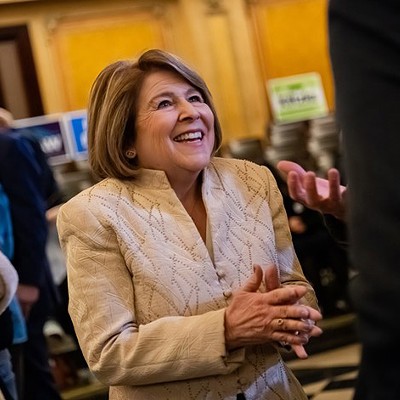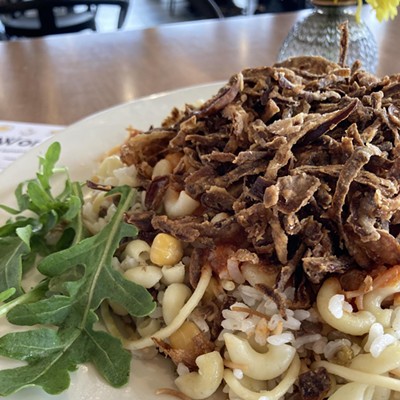On May 3, celebrated author Jess Walter biked to a meeting in downtown Spokane. Afterwards, he decided to go for a leisure ride along the Centennial Trail. To get there, he headed east on Main Avenue. He used the bicycle lane until he got to Browne Street. He knew that cars often turn into the bike lane when they turn right, so he took his bike to the crosswalk to wait for the signal. When the light turned, Walter watched a plumbing truck in the right lane go straight and two pedestrians start crossing. Then, he started pedaling across the intersection. Suddenly, he heard brakes squealing and the roar of an engine that was way too close. Something smacked into his bike, and he flew shoulder first onto the asphalt.
The plumbing truck had slammed on its brakes when a rusted gray Chevrolet Silverado blew through the intersection, running the light five seconds after it turned red. The pickup was heading south on Browne Street at 40 mph. It didn't slow at the intersection. If the pickup hadn't swerved to miss the plumbing truck, it would have hit Walter full on. Instead, it swiped Walter's front tire and sent him sprawling.
"There are so many things you can do wrong as a bike [rider]. But when you do everything right and still get crunched, it's really frustrating," Walter says.
Walter is currently undergoing physical therapy for a separated shoulder, but he mentions repeatedly how fortunate he is. Not many people walk away from a collision with a two-ton steel frame.
The total number of traffic collisions in Washington involving bicyclists and pedestrians decreased during the pandemic. But the percentage of serious or fatal collisions increased in 2021 compared to the average from 2016 to 2020, according to Washington State Department of Transportation (WSDOT) data released at the end of last year. Most bicycle collisions in Spokane result in minor injuries, but many Spokanites still don't feel comfortable biking around the city.
With that in mind, city planners are trying to build a better system of bicycle infrastructure to promote safe biking for residents and visitors. There are a lot of advantages in getting people out of their cars and onto their bikes, for citizens and cities alike. The rider benefits from physical exercise, more flexible parking, a deeper connection to neighbors and nature, and freedom from skyrocketing gas prices. For cities, more bikes on the road mean less noise pollution, less physical stress on roads, fewer parking requirements and cleaner air.
Despite the benefits, Spokane does not make it convenient to bike. The city's transportation infrastructure assumes that everyone drives a car. Roads are built on this assumption, and the prophecy fulfills itself.
Increasing mobility has meant creating larger arterials with higher speed limits, which are the enemy of bike safety. Most bicycle fatalities occur on roads with a speed limit of over 25 mph, according to the WSDOT Active Transportation Plan for 2020 and Beyond. The plan says that if a bicycle is hit directly by a motorist going 20 mph, the rider has a 90 percent chance of survival. But if the motorist is going 40 mph, like the Chevy that barely missed Walter, the chance of surviving drops to 10 percent.
Lauren Pangborn is a member of Spokane's Bicycle Advisory Board, a group of community members advocating for better bicycling in Spokane. Pangborn has been biking in Spokane for seven years. A "reasonably confident cyclist," she feels comfortable crossing high-traffic roads or taking the whole car lane when she needs to. But her extended family doesn't feel the same way.
"I feel for people who are too scared to ride," says Pangborn. "We are victim to this city's land use policy." Pangborn doesn't think there is enough infrastructure connecting the city for most people to meaningfully replace car trips with biking.
"The ability to use a bicycle is hugely dependent on the built environment," says Pablo Monsivais, a public health scholar and associate professor at Washington State University who is also a member of the Bicycle Advisory Board. But instead of creating a safe environment, bike safety education often centers on wearing a helmet or proper clothing. This places a "disproportionate responsibility" on the bicyclist for their own safety.
"It doesn't matter how safely you're biking," Monsivais says. "If you meet hazardous roads, you're still eventually going to lose."
Bicycle collisions in downtown Spokane happen most frequently at intersections with Browne and Division between I-90 and the river, as well as at corners in the neighborhood between the Maple Street Bridge and the interstate, according to collision data mapped out by the Inlander. Most of the roads in these areas are shared by cars and bikes without any separation.
Rhonda Young, professor and chair of the civil engineering department at Gonzaga University, says it's an ethical responsibility to create better road systems that present little to no opportunity for serious injury, even if something goes wrong.
"Sometimes humans make mistakes," Young says. "But those mistakes shouldn't end in death."
Bike lanes are often the initial solution promoted for road safety. For example, construction began on Monday, June 14 on Riverside Avenue, and the redesigned street will include a bike lane between Division and Monroe. Bike infrastructure usually gets tacked on to other construction projects, like when a street is scheduled for resurfacing. As the city plans road maintenance, the Bike Advisory Board watches for opportunities to advocate for biking projects. The process is slow and often results in scattered bike lanes that don't connect the city well.
Also, bike lanes sometimes squeeze bicyclists between fast traffic and parked cars. The lane then becomes an obstacle course, making bicycles watch for swerving motorists on the left and car doors opening on the right. The bike lane on Riverside, however, will try to solve this issue by segregating the bike lane, putting parked cars between motor traffic and bicycles.
Zac Fairbanks of Spoke N Sport, a bicycle repair shop that sees lots of bikes after collisions, isn't convinced that bike lanes, even segregated ones, will make Spokane more bike friendly. It's not clear that bike lanes mean fewer collisions. According to Fairbanks, the main issue is driver negligence and animosity toward bike riders. The bike lane on Main did nothing to protect Walter from an irresponsible driver. Bikes are no match for sedans, SUVs or antagonistic drivers. As long as cars and bikes are close to each other, bicyclists are at risk.
If Spokane wants to get serious about improving bicycle safety, the city has to reimagine what mobility means.
Society has "equated mobility with speed," says Young. People think good movement around the city means they can go fast in their car to wherever they want to be. But Monsivais and Pangborn imagine a city that carefully combines residential, commercial and green spaces. Monsivais calls this "thoughtful density," a growing city that empowers people to walk or bike to local conveniences instead of driving far away to run errands. A similar vision of mobility helped modern cities in the Netherlands and Sweden decrease the need for cars and high speed traffic.
Walter wonders if some streets in Spokane could be reserved for only bicycles and pedestrians. He's wary of interacting with any more motor vehicles after a negligent driver almost killed him.
"I kept hearing the sound of his motor and the screeching brakes," Walter says. Until something changes, Walter has decided "it's not really worth it [to bike] downtown." ♦

